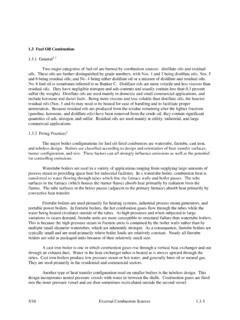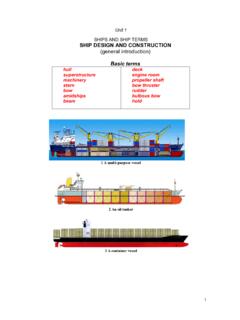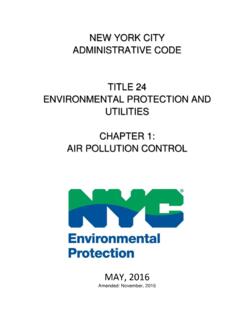Transcription of Wastewater Technology Fact Sheet: Ozone Disinfection
1 United StatesEnvironmental ProtectionAgencyOffice of WaterWashington, 832-F-99-063 September 1999 WastewaterTechnology Fact SheetOzone DisinfectionDESCRIPTIOND isinfection is considered to be the primarymechanism for the inactivation/destruction ofpathogenic organisms to prevent the spread ofwaterborne diseases to downstream users and theenvironment. It is important that Wastewater beadequately treated prior to Disinfection in order forany disinfectant to be effective. Table 1 lists somecommon microorganisms found in domesticwastewater and the diseases associated with is produced when oxygen (O2) molecules aredissociated by an energy source into oxygen atomsand subsequently collide with an oxygen molecule toform an unstable gas, Ozone (O3), which is used todisinfect Wastewater .
2 Most Wastewater treatmentplants generate Ozone by imposing a high voltagealternating current (6 to 20 kilovolts) across adielectric discharge gap that contains anoxygen-bearing gas. Ozone is generated onsitebecause it is unstable and decomposes to elementaloxygen in a short amount of time after is a very strong oxidant and virucide. Themechanisms of Disinfection using Ozone include: Direct oxidation/destruction of the cell wallwith leakage of cellular constituents outsideof the cell. Reactions with radical by-products of ozonedecomposition. Damage to the constituents of the nucleicacids (purines and pyrimidines).
3 Breakage of carbon- nitrogen bonds leadingto 1 INFECTIOUS AGENTSPOTENTIALLY PRESENT IN UNTREATEDDOMESTIC WASTEWATERO rganismDisease CausedBacteriaEscherichia coli(enterotoxigenic)GastroenteritisLept ospira (spp.)LeptospirosisSalmonella typhiTyphoid feverSalmonella (=2,100 serotypes)SalmonellosisShigella (4 spp.)Shigellosis (bacillarydysentery)Vibrio choleraeCholeraProtozoaBalantidium coliBalantidiasisCryptosporidium parvumCryptosporidiosisEntamoeba histolyticaAmebiasis (amoebicdysentery)Giardia lambliaGiardiasisHelminthsAscaris lumbricoidesAscariasisT. soliumTaeniasisTrichuris trichiuraTrichuriasisVirusesEnteroviruse s (72 types, ,polio, echo, and coxsackieviruses)Gastroenteritis,heart anomalies,meningitisHepatitis A virusInfectious hepatitisNorwalk agentGastroenteritisRotavirusGastroenter itisSource.
4 Adapted from Crites and Tchobanoglous, InFeed Gas Preparation Oxygen Production Oxygen Storage Air/Oxygen TreatmentOzone GenerationOzone Contact BasinOzone DestructionRecycleDischargeOff-GasesWhen Ozone decomposes in water, the free radicalshydrogen peroxy (HO2) and hydroxyl (OH) that areformed have great oxidizing capacity and play anactive role in the Disinfection process. It is generallybelieved that the bacteria are destroyed because ofprotoplasmic oxidation resulting in cell walldisintegration (cell lysis).The effectiveness of Disinfection depends on thesusceptibility of the target organisms, the contacttime, and the concentration of the Ozone .
5 A linediagram of the ozonation process is shown in Figure1. The components of an Ozone Disinfection systeminclude feed-gas preparation, Ozone generation, Ozone contacting, and Ozone or pure oxygen is used as the feed-gas sourceand is passed to the Ozone generator at a set flowrate. The energy source for production is generatedby electrical discharge in a gas that contains generators are typically classified by: The control mechanism (either a voltage orfrequency unit). The cooling mechanism (either water, air, orwater plus oil). The physical arrangement of the dielectrics(either vertical or horizontal).
6 The name of the , generators manufactured by differentcompanies have unique characteristics but also havesome common electrical discharge method is the most commonenergy source used to produce Ozone . Extremelydry air or pure oxygen is exposed to a controlled,uniform high-voltage discharge at a high or lowfrequency. The dew point of the feed gas must be-60EC (-76EF) or lower. The gas stream generatedfrom air will contain about to Ozone byweight, whereas pure oxygen will formapproximately two to four times that generation, Ozone is fed into a down-flowcontact chamber containing the Wastewater to bedisinfected.
7 The main purpose of the contactor is totransfer Ozone from the gas bubble into the bulkliquid while providing sufficient contact time fordisinfection. The commonly used contactor typesdiffused bubble (co-current and counter-current) arepositive pressure injection, negative pressure(Venturi), mechanically agitated, and packed Ozone is consumed quickly, it must becontacted uniformly in a near plug flow off-gases from the contact chamber must betreated to destroy any remaining Ozone beforeSource: EPA, 1 Ozone PROCESS SCHEMATIC DIAGRAM release into the atmosphere.
8 Therefore, it isessential to maintain an optimal Ozone dosage forbetter efficiency. When pure oxygen is used as thefeed-gas, the off-gases from the contact chambercan be recycled to generate Ozone or for reuse in theaeration tank. The Ozone off-gases that are notused are sent to the Ozone destruction unit or key process control parameters are dose,mixing, and contact time. An Ozone disinfectionsystem strives for the maximum solubility of ozonein Wastewater , as Disinfection depends on thetransfer of Ozone to the Wastewater . The amount ofozone that will dissolve in Wastewater at a constanttemperature is a function of the partial pressure ofthe gaseous Ozone above the water or in the gasfeed stream.
9 It is critical that all Ozone Disinfection systems bepilot tested and calibrated prior to installation toensure they meet discharge permit requirements fortheir particular Disinfection is generally used at medium tolarge sized plants after at least secondary addition to Disinfection , another common use forozone in Wastewater treatment is odor control. Ozone Disinfection is the least used method in although this Technology has been widelyaccepted in Europe for decades. Ozone treatmenthas the ability to achieve higher levels of disinfectionthan either chlorine or UV, however, the capitalcosts as well as maintenance expenditures are notcompetitive with available alternatives.
10 Ozone istherefore used only sparingly, primarily in specialcases where alternatives are not AND DISADVANTAGESA dvantagesCOzone is more effective than chlorine indestroying viruses and ozonation process utilizes a short contacttime (approximately 10 to 30 minutes). There are no harmful residuals that need tobe removed after ozonation because ozonedecomposes rapidly. After ozonation, there is no regrowth ofmicroorganisms, except for those protectedby the particulates in the Wastewater stream. Ozone is generated onsite, and thus, thereare fewer safety problems associated withshipping and handling.















